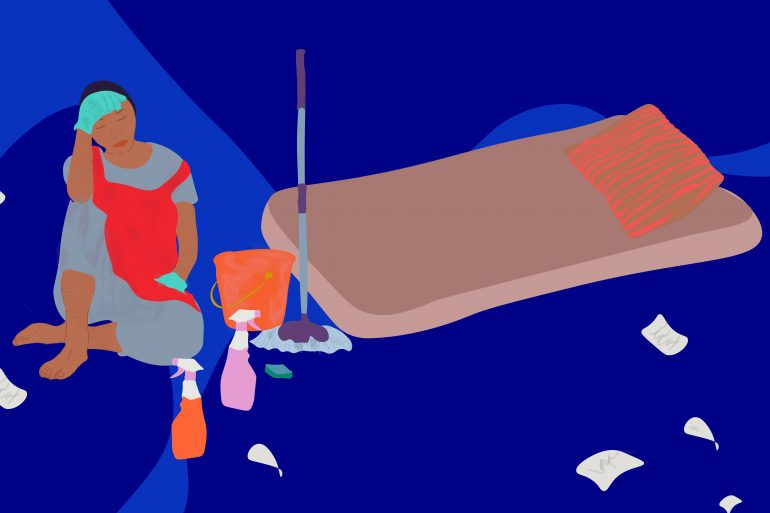Since the pandemic began, articles have appeared about women giving up ‘grooming’ and beauty standards in lockdown. This month is ‘Januhairy’, a movement that encourages women to grow out their body hair. Armpit hair, leg hair, arm hair, yes – but also chest hair, moustaches, beards and back hair. Body hair positivity movements are no longer the domain of white women growing out delicate honey-coloured armpit hair. A quiet revolution is happening on social media, making explicit a narrative that has so far eluded mainstream media: the arbitrary, racialised and colonial association of body hair removal with femininity. The rapid rise to fame of body hair activists shows how necessary they are: certain types of body hair are still ‘taboo’, their visibility causing shockwaves in the media. Investigating the histories of body hair removal, and supporting these new body hair movements, is crucial for resisting the continued policing of femininity.
In June 2019, Montreal-based artist Esther Calixte-Bea released Lavender on her Instagram, a self-photography, self-liberating project. In the photographs, Calixte-Bea wears a lavender-coloured dress she made herself, with a neckline designed to accentuate her decolletage – and, most importantly, her chest hair. Set in organic, green environments, the photographs draw attention to how grass and plants grow as body hair does: both are natural, and beautiful.
https://www.instagram.com/p/BzWnQHUDpTN/
Lavender blew up: Calixte-Bea was interviewed by multiple international news outlets, culminating in a feature in Glamour’s ‘Self-Love’ issue. Similarly, activist Harnaam Kaur decided age 16 to grow out her beard as she wanted to stop feeling ashamed for something that was entirely natural: she has since become a full-time public figure, walked at London Fashion Week, and has featured in high profile news outlets like Teen Vogue and The Guardian. “I don’t think you can put labels on what being feminine is,” Kaur says: femininity is just “something you feel inside of you”. This is also the logic behind Alok Vaid-Menon’s new hashtag #NothingWrongHair: as a non-binary body hair activist, artist and Instagram influencer, they want to create more visual representations of people with body hair of all genders.
Historically, white supremacy and patriarchy have shaped how femininity is embodied. Journalist and model Simran Randhawa writes about how “femininity has been denied to women of colour in different ways across different ethnicities”, and for “Indian women, it is often through our hairiness”. Body hair on women of colour is more stigmatised in Western societies, perhaps in part because of its visibility. The links between body hair removal, femininity and colonialism are contested and understudied; body hair removal practices also have a long and complex history, outside of a Western context. However, in part re-energised by social media discussions, there is a growing impulse to uncover the particular colonial and patriarchal forces that have led to the gendered and racialised stigmatisation of body hair we have today. Through Alok Vaid-Menon’s interview with Rebecca Herzig, I came across Herzig’s book Plucked: A History of Hair Removal (2015), which argues that Charles Darwin’s Descent of Man (1871) laid the foundations for the Western association of body hair removal with white womanhood.
According to Herzig, Darwin transformed perceptions of women’s body hair by associating excessive’ body hair with primitiveness, and by suggesting that “human hairlessness is … a cultivated characteristic”, as well as a ‘female’ one. The very presence of human hair helped to show that we were descended from ‘some ape-like creature’: sexual selection, Darwin suggested, promoted increasing hairlessness, evidence of humans’ choice to obtain “superior beauty and cleanliness”. As Darwin’s evolutionary ideas were absorbed into Western thought more broadly, Herzig argues there was increasing scientific concern with perceived ‘excessive’ hair growth: body hair, and ‘particularly women’s facial hair’, became linked to “evolutionary atavism, individual pathology, sexual inversion and mental illness”. “When nature was functioning properly,” Herzig concludes, “experts after Descent presumed, men had body hair, and women did not”.

Body hair removal became tied not only to an ideal of womanhood, but white womanhood. As founder of Burnt Roti magazine Sharon Dhaliwal says in this interview, “representation of body hair in the media… tends to be white women and… small, blonde wisps of hair”. Herzig tracks this type of representation back to the early 20th century, where the hygiene movement promoted racialised ideals of purity: advertisements showed “clean, athletic figures, whose smooth, sanitised whiteness was crucial to their virtue”. In part, this emphasis on purity and whiteness was a response to “concern about the racial ‘in-betweenness’ of new immigrant groups”: hairiness was perceived as a marker of the racial ‘other’, and so it became an imperative for white women to remove their body hair to disassociate themselves from that racialisation. Herzig discusses how ideals of white womanhood promoted in scientific studies and advertising were so powerful that “tens of thousands – if not hundreds of thousands – of American women” underwent direct x-ray exposure to remove their body hair, often resulting in “scarring, ulceration, cancer, and death”. Insidiously, it was “urban, non-English speaking populations” that were specifically targeted by commercial x-ray salons, alluding in their advertisements to “racial and class mobility”. Western women were removing body hair before this point but, according to Herzig, it was predominantly in the 20th century that it became both racialised and institutionalised.
I find it empowering to realise just how recent and arbitrary Western ideas about body hair and femininity are: these histories expose that they are not inevitable, and can be resisted. As a non-binary activist, Vaid-Menon emphasises how gendered ideas about body hair are still used to police transfeminine people today, who are often told they must remove their body hair to be authenticated in their femininity. Ideas about body hair are often violently inflicted on women: Kaur discusses how she received death threats as she became more well-known, stemming from people’s outrage that she had a beard. The anger and anxiety caused by seeing certain types of body hair on women and non-binary people (and particularly people of colour) speaks to the urgency of these body hair positivity movements.
What is important is that people are allowed to choose: there is, of course, no shame in removing body hair. For many people, hair removal is central to gender expression. Body hair positivity activists aim to disrupt the taboo nature of body hair, to show that growing it out must be as legitimate as removing it. Ideas of what a ‘woman’ are, and what ‘femininity’ is, should not be predicated on the policing of bodies; a hairy body should be just as celebrated as a hairless one.
Through the work of activists like Alok Vaid-Menon, Esther Calixte-Bea and Harnaam Kaur, as well as the movement ‘Januhairy’, the stigmatisation of body hair is being slowly dismantled. Seeing moustaches, beards and chest hair on anyone, of any gender, should not be revolutionary. In the spirit of ‘Januhairy’, follow body hair activists on social media, and perhaps spend some time this month learning about the history of body hair removal and white womanhood: our ideas about what a ‘woman’ looks like need to change.

See more of Rosa’s work on her instagram














